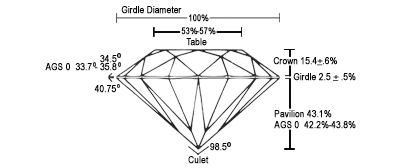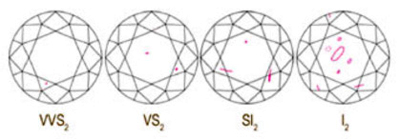Diamond is a natural crystalline mineral consisting of pure transparent carbon. It is the hardest surface known to man, and can only be scratched by another diamond. This may explain why it is the gemstone of choice for jewelry that is subject to every day wear and tear such as engagement and wedding rings.
Diamonds are fascinating, formed very deep within the Earth, and forced to the surface by volcanic eruptions. Since they are approximately 3 billion years old, diamonds are probably the oldest things you will ever own. It is a common misconception that diamonds come primarily from South Africa. They are a worldwide resource and are mined on every continent except Europe and Antarctica.
Diamonds come in many shapes and colors. By far the most popular and traditional shape is the round brilliant cut diamond. Princess, trillion, marquise, emerald, oval, cushion, radiant, pear, heart and Asscher are other shapes you may be familiar with.
What are the 4 Cs?

Cut does not refer to the shape of the diamond; it indicates the arrangement of the diamond’s facets. Polish and symmetry are two important aspects of the cutting process. The polish grade describes the smoothness of the diamond’s facets, and the symmetry grade refers to alignment of the facets.
Cut is the most important of the 4 C’s because it determines the optimum combination of brilliance, scintillation and fire. This has the greatest effect on the beauty of a diamond.

Natural colors in a diamond range from colorless (D), which is extremely rare, to various degrees of yellow, with a spectrum of shadings in between. Many of these color distinctions are so subtle that they are invisible to the untrained eye. But these slight color differences make a very big difference in diamond quality and price.

Clarity is the degree to which identifying characteristics known as inclusions are present in a diamond. A “flawless” diamond has no inclusions visible under a 10-power magnification. But no diamond is absolutely perfect, even though a rare few may come close.
Because they are created deep within the earth, most diamonds contain unique birthmarks called inclusions (internal) and blemishes (external). On the GIA scale the clarity grades range from FL (flawless) to I3, which is a diamond with prominent inclusions.

This is the standard measurement for diamond size. The most obvious variable, it is actually the least important in determining the brilliance and beauty of a diamond.
Diamonds and other gemstones are weighed using metric carats with one carat weighing about the same as a small paper clip, or 0.2 grams. Just as a dollar is divided into 100 pennies, a carat is divided into 100 points, which means that a diamond of 50 points weighs 0.50 carats or a half-carat.

Only a small percentage of diamonds are ideally cut. When a diamond is cut this way, light rays from all sides are bent towards the center of the stone and are reflected back through the top in a blaze of light. If a diamond isn’t ideally cut, light will “leak out” through the sides or bottom of the diamond. The ideal cut guarantees you a spectacular balance of brilliance, scintillation and fire. You can compromise on color, clarity or carat weight, but to ensure that you have the most beautiful diamond possible, you should never compromise on cut. Every Lazare diamond we carry is Ideal cut, and carries a laser inscribed logo and individual identification number for proof of ownership.
